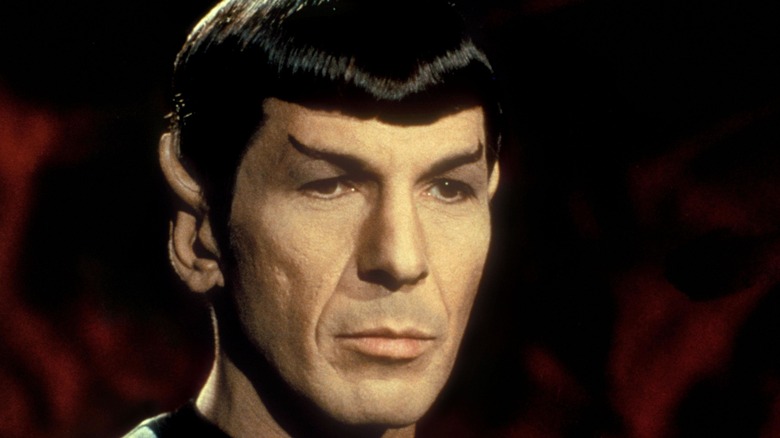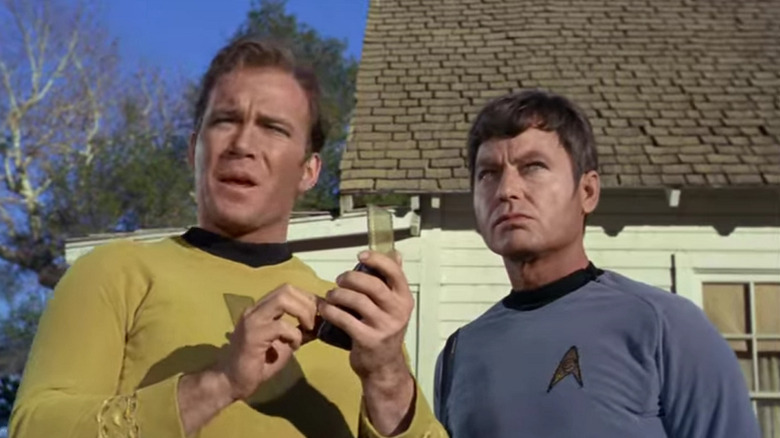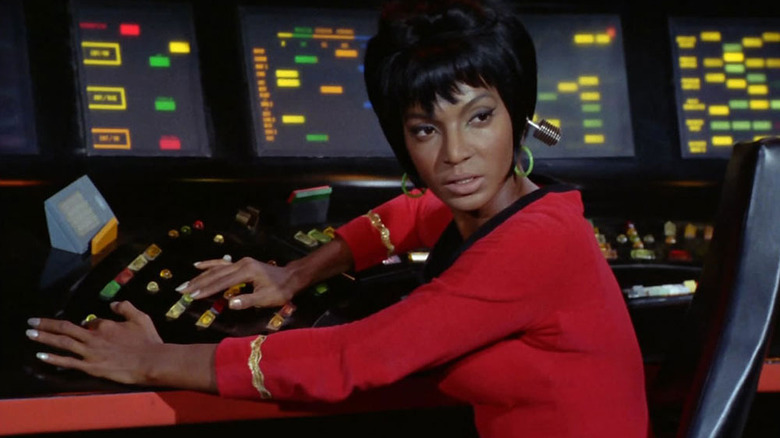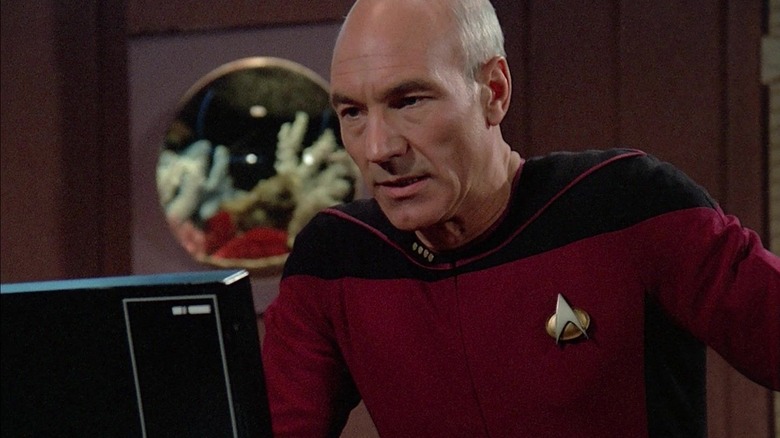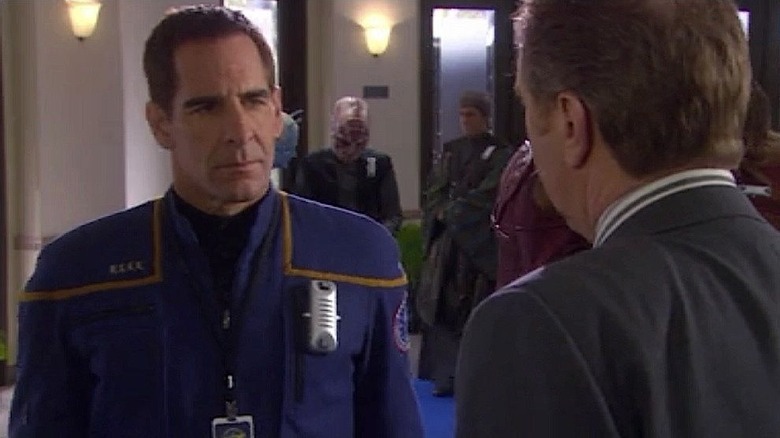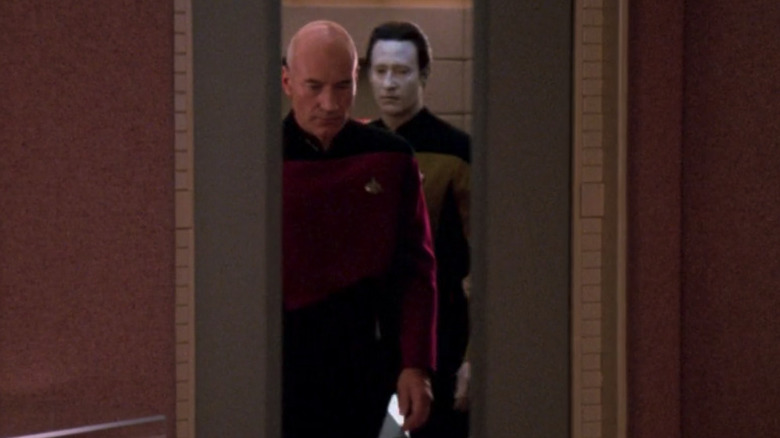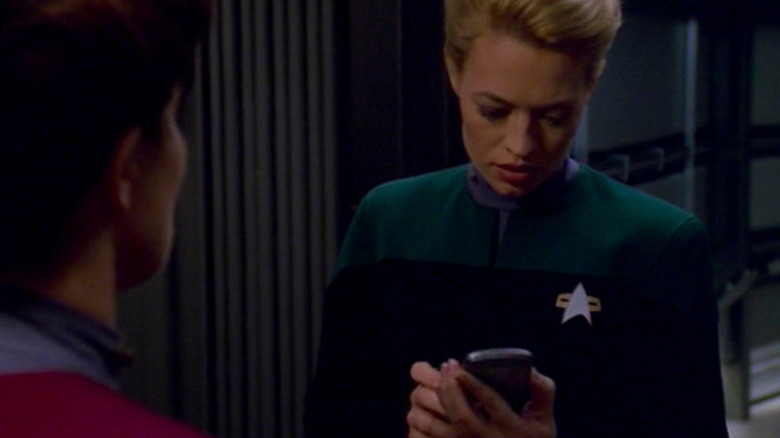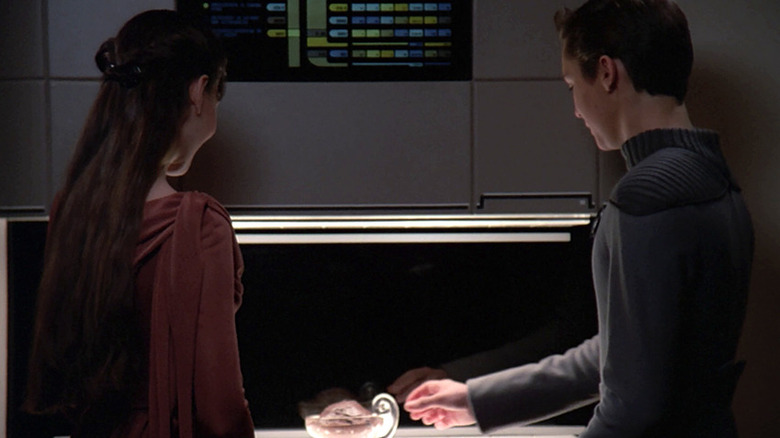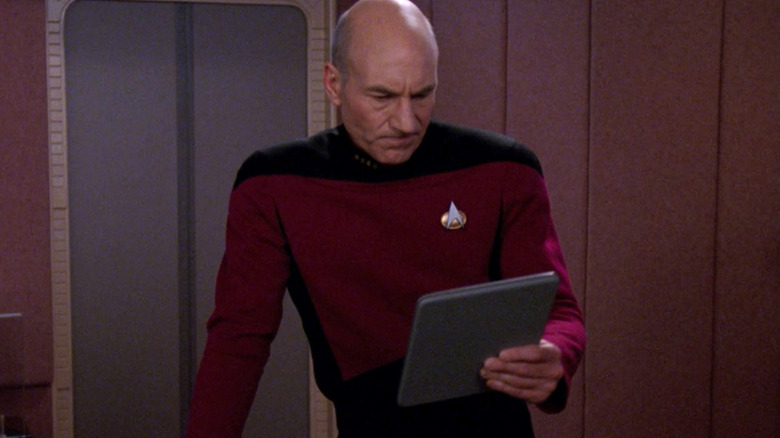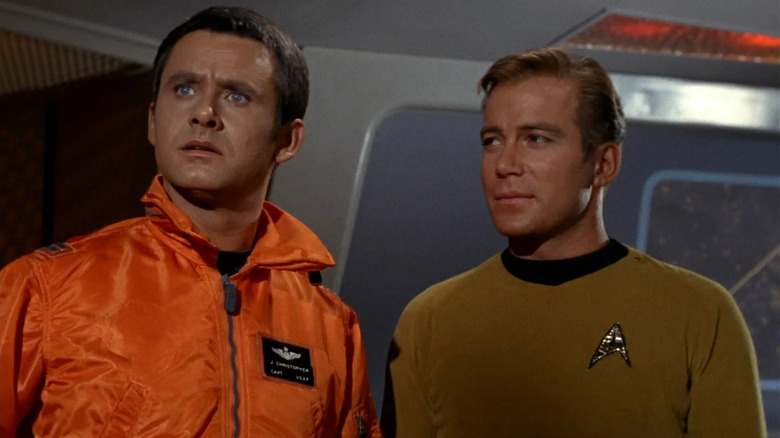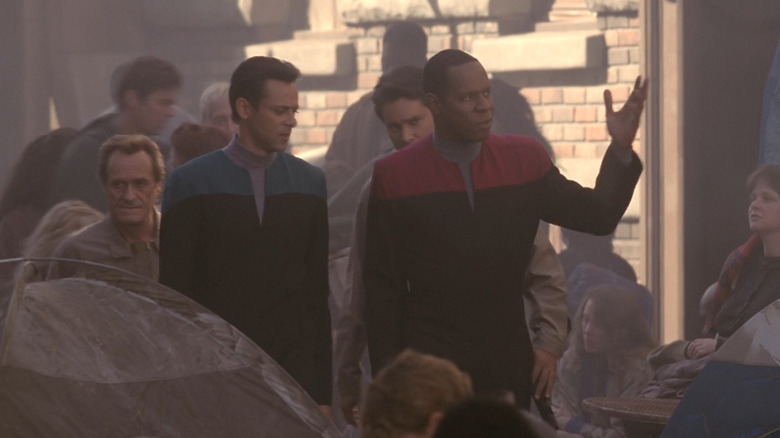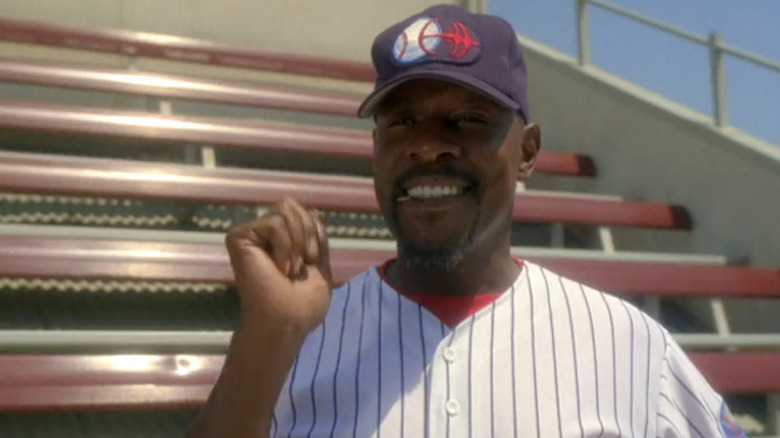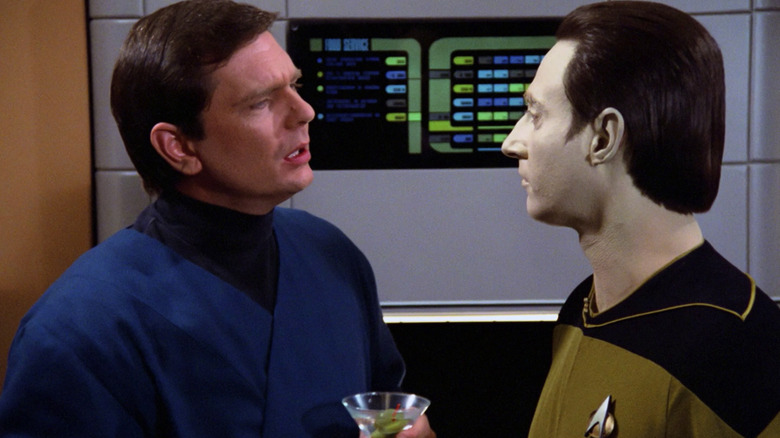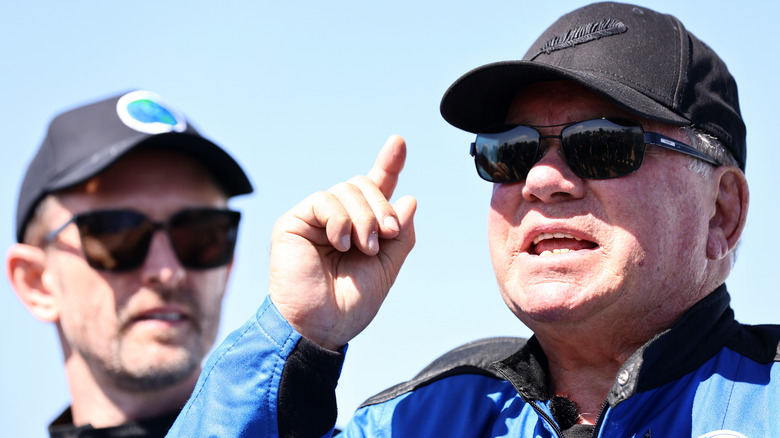Times Star Trek Predicted The Future
As Arthur C. Clarke once said, "trying to predict the future is a discouraging, hazardous occupation." Yet, in 1966, "Star Trek" creator Gene Roddenberry did just that when he set out to create a science fiction program like few others, filled with a sense of realism and believability despite its outlandish concepts and far-future setting. Aboard the starship Enterprise, Captain Kirk and Mr. Spock didn't magically move from planet to planet; they used an advanced warp drive system that was run by a team of officers in the ship's engine room.
Over the years, the franchise has populated its lore with all kinds of technology that extrapolated the world of its day into the world of tomorrow, and in doing so, it made wild predictions about what was to come. Across multiple TV series and a number of films, "Star Trek" even invented its own history of our future, too, with historic events that wound past our present day and into the world of Kirk, Spock, and beyond. But how much did they get right?
Mobile communicators
The first (and perhaps most obvious) tech device to become reality and make a real impact on our world was the flip-top communicator. It's been a long-held belief that Motorola engineer Martin Cooper — who developed the first cell phone — had been inspired by Captain Kirk and his communicator. Some sources, such as CBR, have called the claim apocryphal, but whatever the true inspiration for the device, the first commercial cell phones began popping up in the early 1980s, nearly 20 years after the original "Star Trek" series (via QZ).
Years later, in the mid-1990s, cell phone technology would evolve one step closer to the flip-top devices used by the crew of the Enterprise when Motorola introduced the StarTAC, the world's first flip-open cellular phone (via CNET). Wildly popular for its portability, even "Star Trek" star Leonard Nimoy used one, and according to Gizmodo, he laughed about its striking resemblance to the communicator used by his character Spock. While cell phones have since evolved into the full screen smart phone form factor, folding phones are making a comeback, too, with the Motorola RAZR and the Galaxy Z Flip bringing the flip-open cell phone to the next generation.
Bluetooth earpieces
Audiences in 1966 who tuned in to "Star Trek" weren't just treated to unprecedented levels of diversity among the Enterprise's crew, but plenty of technology that must have seemed unbelievably futuristic. One such piece of tech that — unlike communicators or tricorders — was more humbly a part of the background was Lt. Uhura's wireless earpiece. The communications officer, who was tasked with hailing approaching ships and passing subspace messages to the captain, wore a large cylindrical device that protruded from her ear and seemed to be feeding her audio. But unlike ordinary headphone tech from the time — which was large and bulky, and limited to the most serious of audiophiles, as seen in early ads shown on Flashbak – there was no cable or cord to connect it to her terminal.
Instead, Uhura's earpiece seemed to be able to transmit audio wirelessly, which must have seemed almost magical by the standards of the day, and certainly like nothing audiences had seen before. Flash forward 30-some years, however (via Ssense), and her audio receiver and its technology began to closely resemble bluetooth earpieces. Today, almost everyone owns a similar device, such as Apple's Airpods, designed to allow users to transmit audio wirelessly from just about any device.
Virtual assistants
From the earliest days on "Star Trek," one of the defining pieces of technology on the Enterprise was its incredible computer system. In an era when most people barely understood what a computer could do, let alone owned one, the crew of the Enterprise was asking the computer to perform all manner of operations. It was a seemingly endless library and database as much as it was a machine to perform complex calculations — the kind of thing only a science fiction writer could dream of. And it was all operated with a complex voice interface, with users addressing a seemingly invisible assistant called "computer."
Most readers may not even think much of it, but today, many are accustomed to regularly talking to virtual assistants like Alexa and Siri, which are instructed in a similar manner as the likes of Kirk and Picard did their computers. It's likely that you've used such an assistant at some point, too, even if you don't realize it, as the devices become linked to more and more devices like household appliances (via CNET). Humanity has come a long way since the first virtual assistants, but still has a while before it gets to the truly immersive experience seen on "Star Trek," as the current crop of virtual assistants still have some functional limitations. But as explained by Venture Beat, it might not be as far off as you think.
Universal translators
Of all the devices on "Star Trek," it might be the universal translator that is most necessary to make the entire concept of the series work. Rarely in science fiction are audiences ever clued in to how different alien races are able to communicate with each other, with writers usually hand-waving it as a necessary function for television. But on "Star Trek," the crew used a device that automatically translated every language, allowing humans and aliens alike the ability to communicate. Some episodes were even based around the device breaking down and causing communication problems, or a language too unusual for the device to work with, such as the "TNG" episode "Darmok."
While most translation in the real world required the use of a human intermediary, in recent years, digital devices have allowed anyone access to technology that will translate foreign languages in real time. Augmented reality apps like Word Lens (via Wired) translate street signs, and online apps like Google Translate (via the Independent) can provide quick and easy language conversions. More recently, devices like the Pocketalk allow users to translate conversation in real time, just like the crew of the Enterprise. Just don't expect their mouths to match what you're hearing!
Automatically opening doors
From the earliest "Star Trek" to the newest, the futuristic automatic sliding doors have been a mainstay of the franchise. Today, that sort of technology has become so common that contemporary audiences would be forgiven for not realizing they were originally achieved on set with a primitive pulley system, as explained by the Star Trek website (and that often went wrong, according to blooper reels). It always seemed to know when someone wanted to get in, even if they were standing right in front of it but weren't ready to go through. Today, technology can do just that.
You may know how common it is to see automatic sliding doors in shopping malls, supermarkets, and office buildings, but the technology has come a long way since its first introduction in the late 1960s, according to ButterflyMX. Those early doors used pressure sensitive actuators, while later models added motion sensor technology. Newer automatic doors are much more like those in "Star Trek" and do away with the long delays associated with earlier models (via Pocket-Lint). Advanced 3D scanners can even anticipate incoming motion and open the doors ahead of a person, much like those seen on the Enterprise. Because it can also determine whether a person is facing it with facial recognition software, it can close behind a person even when someone else might be walking by, preventing accidental openings and delayed closings.
Pocket devices
The original "Star Trek" series featured everyday tech for the crew, including phasers and communicators. But often their most trusted device was the tricorder, a scanning device used mostly on away missions to gather information. Moving ahead to "The Next Generation" and beyond, however, the tricorder evolved into a small, handheld — often folding — device that could fit into a pocket, capable of doing just about anything an officer would need on a mission. From analyzing sensor readings, recording data, mapping terrain, to assessing injuries, it had a great many functions. It was a wondrous device that must have defied comprehension — how could a single, small, handheld device do so many things?
Today, nearly everyone has a device that can do even more than a tricorder: the modern smartphone. The thousands upon thousands of apps available on most smartphones allow us to do almost anything we need in our day-to-day activities, and its web access makes it an endless database, too. There are even some add-ons and apps that turn your phone into a medical scanning device, according to CNET, as the line between "Star Trek" tricorders and today's most advanced handheld devices blurs more and more each day. In fact, The Atlantic says the smartphone may have surpassed it already.
Replicators
"Star Trek: The Original Series" had matter synthesizers that could re-sequence matter to create food, and sometimes uniforms. Though limited in their capabilities, they were incredible inventions that in 1966 seemed indeed like the kind of technology that would be hundreds of years away. "Star Trek: The Next Generation" went one step further, introducing replicators capable of creating just about anything — from clothes and food to trinkets and tools — seemingly out of thin air. Even 20 years after the original series, this technology still felt centuries away to audiences in the '80s.
Yet, here in the 21st century, we've begun developing technology that can effectively do what replicators and matter synthesizers did. Though they operate on vastly different principles, today's advanced 3D printers are capable of recreating solid objects with resin and plastic, even if the process is slow and complicated. Meanwhile, a bleeding edge technology reviewed by Wonder How To can use a kind of 3D printer to create edible food, including fruit. Another device has begun expanding on similar technology. With primitive versions of the technology already here, who knows how close "Star Trek" replicators really are?
Portable computer tablets
Though the original "Star Trek" series showed officers walking around with a kind of tablet computer, they were large and boxy devices with three small lightbulbs and seemed to be more like digital notepads. Whatever their original intention was, they evolved into the PADD (Personal Access Display Device) seen on "The Next Generation" and beyond. Essentially a portable extension of the Enterprise's computer, officers were seen using these devices to do everything from write books and read plays to performing research and analyzing data.
While many had attempted tablet computers, with the earliest appearing as far back as 1989, few had found any level of breakthrough success until Apple introduced the iPad in 2010 (via Business Insider). Finally, consumers had a thin, lightweight device in a convenient size that they could consume and create content on, and all for a relatively affordable price. Today, touchscreen tablets have become more than just for watching movies, with iPads being used by students, executives, artists, and businesses of all kinds. In many ways, iPads of the real world have become more useful and more versatile than those seen on "Star Trek."
The Moon landing
When it comes to "Star Trek" predicting the future, it's not just clairvoyance with technology, but with some key historical events as well. Though not exactly the most difficult thing to predict in 1967, given President John F. Kennedy's promise to land a man on the moon by the end of the decade, "Star Trek" nevertheless made some pretty accurate calls regarding the ultimate event. It happened in the first season episode "Tomorrow Is Yesterday," in which Captain Kirk and the Enterprise traveled back in time to the relative "present day" of 1969, which was still two years into the future when the episode originally aired.
In the episode, the crew's unwitting visit to the past causes problems when they are spotted by the U.S. military and must find a way of ensuring they don't change history. But while scanning for transmissions, Lt. Uhura intercepts a news broadcast that describes the planned launch of the historic moon landing. But not only did the series predict the year and crew compliment, they predicted the day, as the broadcast claims the launch — with its three astronauts — is scheduled for the following Wednesday. As recorded by NASA, when Apollo 11 did depart the Earth for the moon in 1969, it was Neil Armstrong, Buzz Aldrin, and Michael Collins, all launching on Wednesday, July 16, 1969.
Civil unrest in the 2020s
Aired in 1995, the "Deep Space Nine" episode "Past Tense" saw Captain Benjamin Sisko, Julian Bashir, and Jadzia Dax sent back in time to 2024 San Francisco, just before a major historic event in the "Star Trek" timeline. According to Sisko, their landing coincided with an infamous civil protest that turned into a violent riot, led by a man named Gabriel Bell. Sparked in a homeless encampment called a "Sanctuary District," Bashir accidentally gets Bell killed, and it's up to Sisko to ensure that history repeats itself.
The future of 2024, then more than 30 years in the future, bears a number of striking similarities to the events of the real 2020s, as analyzed by Vox. From homeless encampments to the protests and civil unrest, the class divide, and even the internet as a tool for people to share their experiences. And while the riot in the episode wasn't racially motivated, the choice to make the leader of the revolt a black man doesn't seem like a coincidence. After all, the LA Riots were just a few years old (per NPR), and the story in "Past Tense" very much feels like an extrapolation of those events. Sadly, the producers were all too right, and that the real 2020s don't seem very far off from what's seen in the two-parter, illustrating with crystal clarity how very little has changed with race relations in the U.S.
The 1999 Yankees
Technology, politics, and history, "Star Trek" has predicted it all. When it comes to baseball, though, its success rate is a bit more spotty. In "The Next Generation," they predicted the game to truly go global with the London Kings mentioned as a club in 2015. Part of the Planetary Baseball League, they were led by rookie sensation Buck Bokai, who'd go on to break Joe Dimaggio's hit streak record in 2026. While that's clearly off base, one forward-looking prediction they did get right was the Yankees' late '90s championships.
In the "Deep Space Nine" two-parter "Past Tense," Sisko had a chat with a local security officer about the greatest clubs that ever played the game. While Vin picked the '15 Kings, Sisko opts for the '99 Yankees. The prediction of the '99 Yankees as one of the greatest teams in baseball history is impressive because at the time it was aired, in January 1995, the Yankees hadn't made the postseason in almost 15 years. The real 1999 Yankees were World Series winners, triumphing in a sweep of the Atlanta Braves (via Baseball Reference), though admittedly it's the 1998 Yankees — who set an American League record with 114 wins — who have been recognized by Bleacher Report as one of the best teams of all time. Perhaps baseball historians were a little off in the 24th century.
Heading that way: the death of television
In several episodes of "Star Trek," it's noted that the medium of television had died out some time ago. It's made most clear in the "Next Generation" episode "The Neutral Zone" when three people from the 20th century are reawoken from cryogenic stasis. Looking for the "boob tube," Commander Data informs one of them that "that particular form of entertainment did not last much beyond the year 2040." While 2040 is still some 20 years away, technology is definitely headed in that direction, with broadcast television slowly dying (via The Street), and reports from outlets like Variety and Yahoo talking about the death of cable television. In fact, a recent article from The Washington Post said it plainly: television is already done.
As more and more audiences move to streaming services like Netflix, Amazon, and Disney+, it seems the days of television are indeed numbered. So 2040 seems like as good a guess as any as to when the medium may fall off entirely, as more and more viewers cut the cord and move their primary viewing habits online. It may seem like an odd call for a television series to make about its own future, but so far, it looks like it's another "Star Trek" prediction that could be right on the money.
Sending Bill Shatner to space
Of all the predictions that "Star Trek" made, from 1966 to today, this one might be the most unbelievable. As the star of the original "Star Trek" series, William Shatner played the indomitable Captain James T. Kirk, commander of the starship Enterprise. As the iconic captain, he boldly went where none had gone before, in an era where few had ever ventured into space. How then, could anyone have predicted that Shatner himself, some 55 years after first venturing into space aboard the Enterprise as Captain Kirk, would go into space himself?
In 2021, at the age of 90, Shatner boarded the private space flight Blue Origin, funded by Amazon founder Jeff Bezos. After returning to Earth, it seemed the experience had changed him. After becoming the oldest person in outer space, according to the New York Times, he came back and shared how the flight had moved him, saying, "You're looking into blackness — into black ugliness. And you look down, there's the blue down there [on Earth], and the black up there ... There is Mother Earth and comfort and — is there death? Is that the way death is?" (via CNBC).
"Star Trek" has shown us a future where all of mankind can travel the stars, so let's hope that's one prediction that comes true.
